Episodes in the Life of Bounce
Playing with a rubber ball
Carlin Wing

Bounce does not belong to any one object, surface, or body. It is a property distributed among these things: a name for those kinds of collisions from which all of the entities involved emerge with their respective shapes and speeds relatively intact. Which is to say, they survive.[3] And although bounce, as an idea, does not require or depend on rubber, rubber plays a special role in the history of bounce because its primary material property is elasticity. [4] Today, rubber is defined at the scale of the polymer responsible for its elastic character: “Polyisoprene, especially when chemically modified by vulcanization, has the remarkable ability to substantially return to its original shape after being stretched considerably. Any material which fulfills this requirement is entitled to be called rubber.”[5] About half of the world’s current supply of rubber is made from extracted tree sap while the other half is synthesized from petroleum and coal waste products. The labor of rubber production occurs on plantations, in oil fields, in laboratories, and on factory floors. Rubber products are critical for conducting all heavy industry, are wrapped up in our most intimate daily practices, and sit at the center of our most spectacular rituals.
The foundational material of modern sport, rubber is used to make sneaker soles, track surfaces, bicycle and car tires, gym mats, swimming goggles, diving masks, exercise balls, and, of course, many different kinds of sports balls. Rubber balls bounce higher, faster, longer, and altogether more dramatically than balls made using cork cores, wrapped strips of cloth, or inflated pigs’ bladders. Their bounce is extraordinary, even magical. Rubber is especially good at encasing air, holding onto it in a manner that allows hollow tubes, spheres, or other objects to maintain a distinct internal air pressure, in defiance of the external environment. Rubber’s elastic properties give it an uncanny ability to mediate impact, and to make that impact measurable. The moment when the rubber meets the road or rebounds off the racket, an aspect of the world is tested out and becomes apparent. It is a moment of truth. What follows are some stories drawn from the history of rubber bounce: a series of speculations about sporting cosmologies, creolized technologies, institutionalized play forms, and channeled virtuosities.
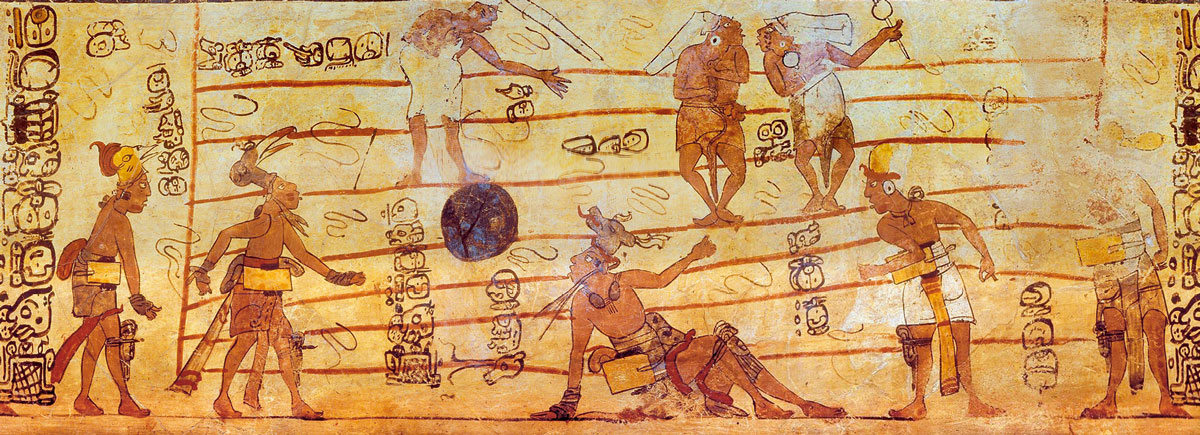
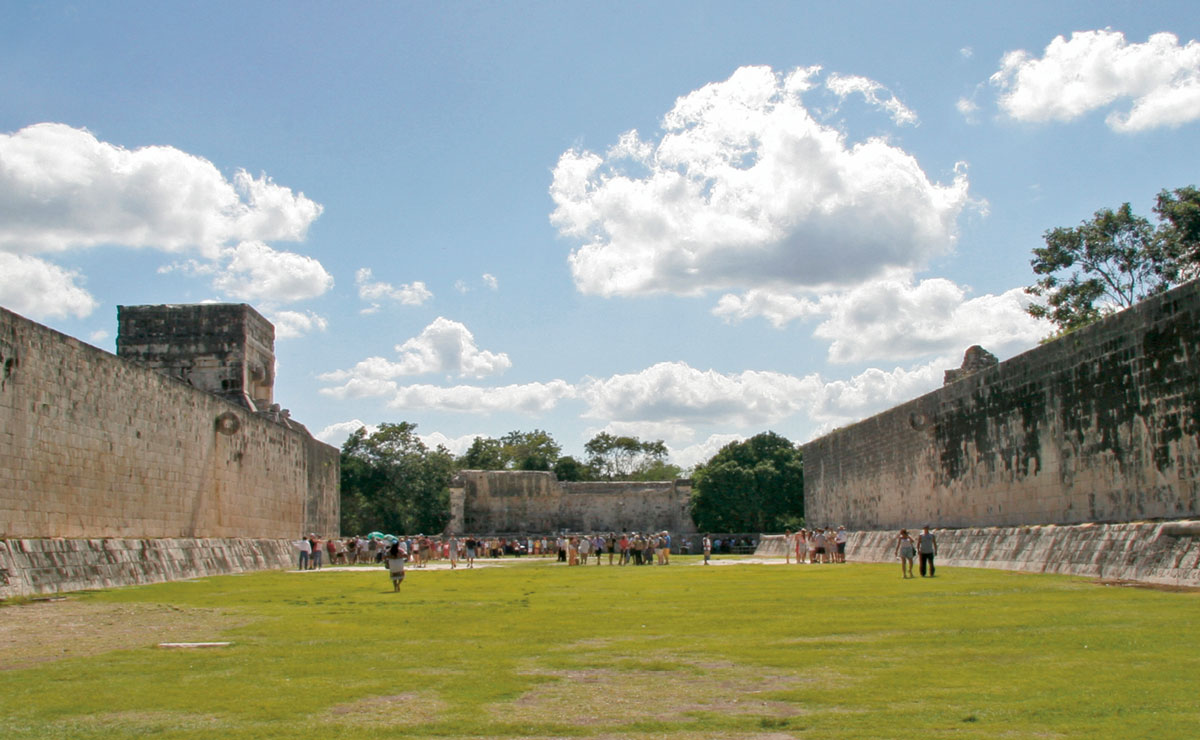
The first recorded demonstration of rubber bounce on the European continent took place in 1528, when Hernán Cortés arrived at the court of Charles V with a troupe of Aztec performers in tow.[11] The Aztec contingent included a dozen ballplayers from Tlaxcala.[12] Although the visit as a whole was not well documented, it did occasion one of the earliest depictions of Aztecs in Europe: a series of drawings by Christoph Weiditz, who happened to be at the court seeking a royal patent that would allow him to continue his profession of striking portraits of nobles out of metal. Included in the series is a drawing of two ballplayers, whom Weiditz positions on slightly sloping grassy ground, with their carefully detailed muscular bodies facing away from each other, as one waits to receive the ball that the other has just directed toward him with his hips. Both the composition and the caption emphasize what would have been one of the most unusual features of the game to the European artist: “In this way the Indians play with the inflated ball, with their buttocks without raising their hands from the ground; they also have a hard leather [protector] over their buttocks to receive the impact of the ball; they are also wearing similar leather gloves.”[13] Weiditz seems to mistake the material technology at hand. His description of the ball as “inflated” is contradicted in an account by Gonzalo Fernández de Oviedo y Valdés, the well-known chronicler of the conquest, and by the majority of the archaeological record. The balls were, for the most part, solid. It seems likely that Weiditz based his assumption on the ball’s liveliness. His presumption about the ball would have made him unable to fully understand why the players were using their hips, elbows, and thighs to direct it. John Fox, an anthropologist who has researched the ancient ball courts extensively, describes never quite understanding why the most common version of the game was organized around striking the ball with the hips until he visited a village where a modern version of the game, called ulama, is still played and “felt the blow of a ball against [his] body.”[14] Hands and feet (our instruments of choice in many ball sports today) are too fragile and puny to provide the necessary force or control for this kind of ball, which can kill a player unlucky enough to be hit in the head or chest. Breaking is one of the alternatives to bouncing. And it usually brings about the end of play.
Weiditz’s drawing is itself a striking representation of bodies at play. But as a representation of sport, it is lacking. He does not represent the rules, the architecture, or the team-based structure of the game, either visually or verbally. We have no other description of the performance at the court of Charles V, so we cannot say for sure what it consisted of, but we do know that it was not merely two players but rather two full teams of ballplayers who arrived with Cortés. Even lacking the architecture of a ball court, some temporary boundaries would have been set to make play possible. And there would likely have been architecture ready at hand. Although Europe did not have anything like the long tradition of institutionalized ball play found in the Americas, it was in the midst of its own ball game craze. Early iterations of pallone, jai alai, rugby, football, and tennis were being played across the continent, and, like the Mesoamerican game, these offered a site for high-stakes gambling by gaming spectators. The early form of tennis, also known as jeu de paume or pallacorda, was wildly popular: courts could be found in every city and in most small towns. Antonio Scaino’s Trattato della Palla Corda (Treatise on the Game of the Ball), the first published codification of a European sport, would appear in print in 1555, just twenty-five years after the Aztec demonstration. Charles himself was an enthusiastic player of the game, with multiple enclosed tennis courts in at least one of his palaces. The elite class of Europe at the time was using balls and ball games as a metaphor for understanding and communicating a new social and natural order of things, which on the surface makes it a little strange that there is not more of a record of the reaction to the Aztecs’ dramatic demonstration of their ball game, and raises the question: why didn’t rubber technology make the leap across the ocean at this moment?
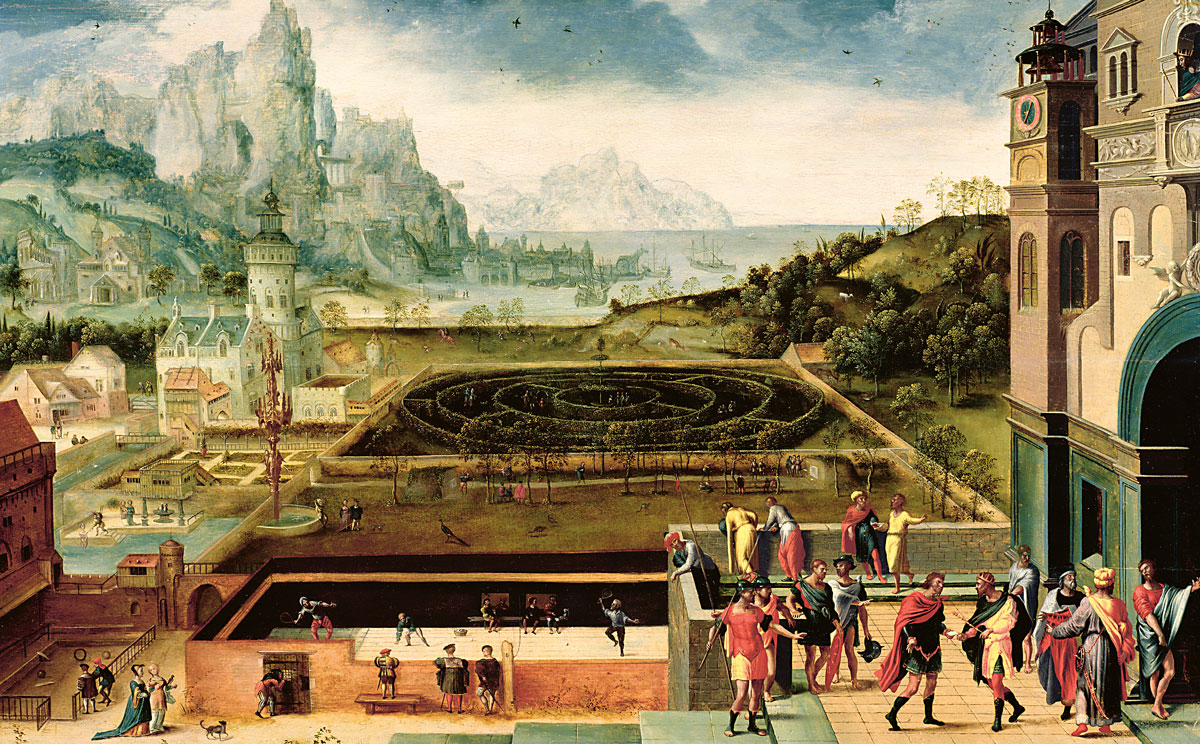
Historian of science Londa Schiebinger tells us to look at instances of the “nontransfer of important bodies of knowledge from the New World into Europe” in order to reframe “questions about ‘how we know’ to include questions about what we do not know, and why not.”[15] Her point is that, often, ignorance is not an absence, but an outcome of cultural and political struggles. This was the case here, played out in the realm of technical knowledge: while the colonizers did record the Aztec process for making rubber balls, including the use of juice from the Ipomoea alba species of morning glories in the processing of the latex, they failed to recognize the key role that this sulfur-rich liquid played in enabling rubber objects to hold their form across time and temperature.[16] (It should be noted that practicalities also played a role; liquid latex did not travel well, and it had a strong odor, especially when exposed to heat.) But perhaps most importantly, the Europeans recognized neither the deep semantic power of the material nor its related economic value. For Mesoamerican societies, rubber was etymologically bound up with its extraction form—and with the body, power, pain, and magic. The indigenous names—which translate as “blood,” “tears of the tree,” “milk of tree”—figure rubber as a bodily fluid, one that requires some rip in the body’s skin or psyche before it can pour forth. As well as using it to make balls for their ritual games, these societies burned it as incense, used it for waterproofing and hafting weapons, and, in its liquid form, to mark the bodies of those about to be sacrificed to the gods. For the Aztec, it was a tribute material, demanded as payment from conquered peoples. But the conquistadors had arrived with a clear idea of what materials they wanted to amass: silver, gold, and other precious metals. In their scheme of things, rubber was neither sacred nor especially economically valuable, and ball games were not the kind of activity that warranted serious cultural representation. In Europe, sport was not sport as we know it, quite yet.
The British and American inventors who took up the material problem of rubber understood themselves as the inventors of a new technology; they were not interested in the Americas as a place from which to learn about bounce, but saw it simply as a site for the extraction of raw materials.[18] It was the American Charles Goodyear who, after years of failed attempts and multiple bankruptcies, discovered (anew) the capacity of sulfur to cure rubber of its undesirable properties. But it was Englishman Thomas Hancock who won the race to the patent office by claiming the British patent in 1843, just months before Goodyear’s us claim in 1844. And it was Hancock who, in a gesture typical of his time, named the process of adding sulfur to cured latex at high temperatures vulcanization. The name had been suggested to him by his friend William Brockedon— painter, inventor, and author of books such as Italy, Classical, Historical, and Picturesque. Its adoption had predictable consequences. Invoking the Roman god of fire and technology to describe the process of using heat, mastication, and additives to cure rubber of its ills and make it a viable and desirable material further dislocated the technology from its origins in Mesoamerican society, papering over this history with a literally classical humanist reach back to Ancient Rome as the foundation of all modern knowledge.
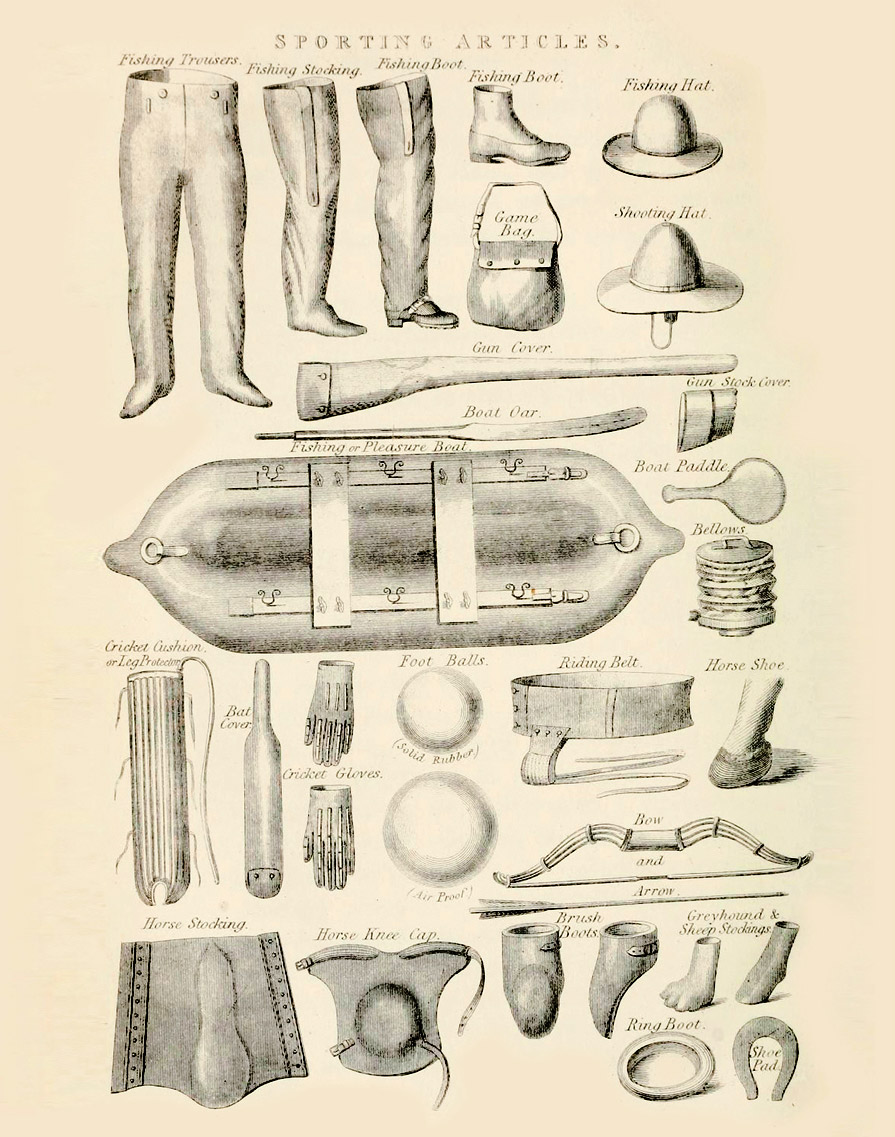
Hancock himself did not have any special investment in sports. Sports equipment was simply one of many kinds of things that could be made better with the new industrial methods and materials. In his 1857 autobiographical account The Origin and Process of India Rubber Manufacture, Hancock breaks down the exhaustive list of rubber products into categories including Airproof Goods; Mechanical Purposes; Portable Boats; Mechanical Articles; Surgical and Hospital Articles; Domestic Articles; and Sporting Articles. Various kinds of balls appear across these categories, including an “Inflated Globe (for Letters)” in the nautical category; a playing ball was included, along with chest expanders, soap and sponge bags, ladies’ and gents’ bathing caps, and nipples, in the category of Domestic Articles; and two footballs (“Solid Rubber” and “Airproof”) featured among the Sporting Articles. The items in this last category make visible two competing definitions of sport. On the one hand, sport continued to be a direct contest with Nature—one that required the assistance of shooting and fishing hats, gun covers, bows and arrows, stockings for horses and greyhounds, and so on. On the other hand, the footballs, cricket gloves, and leg protectors were evidence of the dawning of a new kind of sporting life.
The modern notion of sport that emerged in mid-nineteenth-century England was undergirded by new industrial materials, technologies, and practices, and was articulated through the ethos of Muscular Christianity, which promoted the demonstration of Christian ideals of honor and the development of character through vigorous physical activity, especially through sport and military and civil service. It was an adaptation of an argument made by Renaissance humanists in Italy, who had been drawing, in turn, on a classical Greek and Roman idea about the connection between physical and moral character. Victorian public schools’ cricket, football, and rugby fields, and their fives, rackets, and squash courts, became the primary stage for the regular performance of this ethos. Schoolboys were first encouraged and then required to pick up rackets, bats, and balls so that they could be kept in line (and out of trouble). Thomas Hughes’s 1881 semi-autobiographical book Tom Brown’s School Days paints a vivid scene of how ball play molded the nation’s elite youth—body and soul—into future overseers of empire. Hughes’s book is the most famous of the genre of schoolboy novels. It is credited with motivating the emerging middle class to send their children to such schools in droves and with captivating the Frenchman Pierre de Coubertin, who went on to make the modern Olympics in the spirit of British sport. Our enthusiasm for Harry Potter’s heroic pursuit of the golden snitch makes it clear that we are still in the genre’s thrall today.
Many of the ideals of Muscular Christianity were old ideas of honor and sacrifice rearticulated as ideas of fair play and team loyalty. What was modern about the modern notion of sport was the new emphasis on codified rules, regular training, and, most of all, record keeping. Historian of tennis Heiner Gillmeister describes how “at a time when capitalist entrepreneurs strove for the manufacture of ever better products in even less time, sportsmen began to measure, not the output of the machine, but the efficiency of the human body, by comparing their performances with earlier ones, with a view to improving them. Such experimenting is borne out by the appearance of records: the keeping of times and the results of matches.”[19] Record keeping made it more important for the instruments and architectures of play to be constant and consistent, so that the comparison across matches could be held valid. Both rubber technology and the rule-bound nature of ball games contributed to this quest for consistency. When Hancock’s book was first published, india rubber was just one of the subcategories under the British patent office’s “Class 132: Toys, Games, and Exercises.” It was catalogued under the umbrella category of balls, and kept company with other materials such as wood, metal, plastic, ivory, glass, and, after 1866, celluloid. By 1909, toys and exercises had dropped out of the picture. The class was now simply called “Games,” and gutta-percha and india rubber had become a single category within it that stood opposed to a second category of all “other balls not composed mainly of india-rubber, gutta-percha, and the like.”[20] Writing in 1903 about ball games in general, Eustace Miles comments that both “the Courts and the balls have grown more and more true and uniform, more and more reliable.”[21]

For tennis, which in the early modern era was a game of ricochet played in asymmetrical, enclosed courts with elaborately complicated rules, the introduction of rubber brought with it a dramatic transformation in form. In 1874, Major Walter Clopton Wingfield patented a “New and Improved Court for Playing the Ancient Game of Tennis.” Wingfield’s game, sold with a drastically simplified rulebook, came in a box and could be set up on any open lawn. It was made possible by new rubber balls filled with pressurized air that “proved to be real bouncing bombs even on turf.”[22] Now that the ball had its own bounce, the surfaces no longer had to do all of the work and “the solid walls encompassing the ancient tennis court … the shelter of its roof …[and] also its hard tiled floor which alone had prompted a reaction from the stuffed tennis-balls of old,” became unnecessary.[23] Because the game now required less architecture, it became more portable: a hard cultural form capable of doing the work of empire.[24] The rise of rubber in sport was tied to its new role as a primary material of the Industrial Revolution, which was in turn dependent on the British colonial endeavor. If the beginning of the nineteenth century saw the linguistic dislocation of the history of rubber technology, its close saw the material dislocation (through physical transplantation) of the trees themselves after the head of Kew Gardens commissioned Henry Wickham to gather Hevea brasiliensis seeds from Brazil in order to secure the supply of rubber by turning it into a plantation crop in the East Indies.[25] The company started by John Boyd Dunlop became one of the first multinationals, and by the early twentieth century, Dunlop Rubber was the single largest landowner in the Straits Settlements, the colonial territories that are now part of Malaysia, and was the parent company of Dunlop Sport, one of the longest-running manufacturers of golf, cricket, and racket sport equipment.[26] The ethos of fair play relied then, as it does today, on a dramatically unequal system of labor and economics to produce the instruments of better, truer bounce.
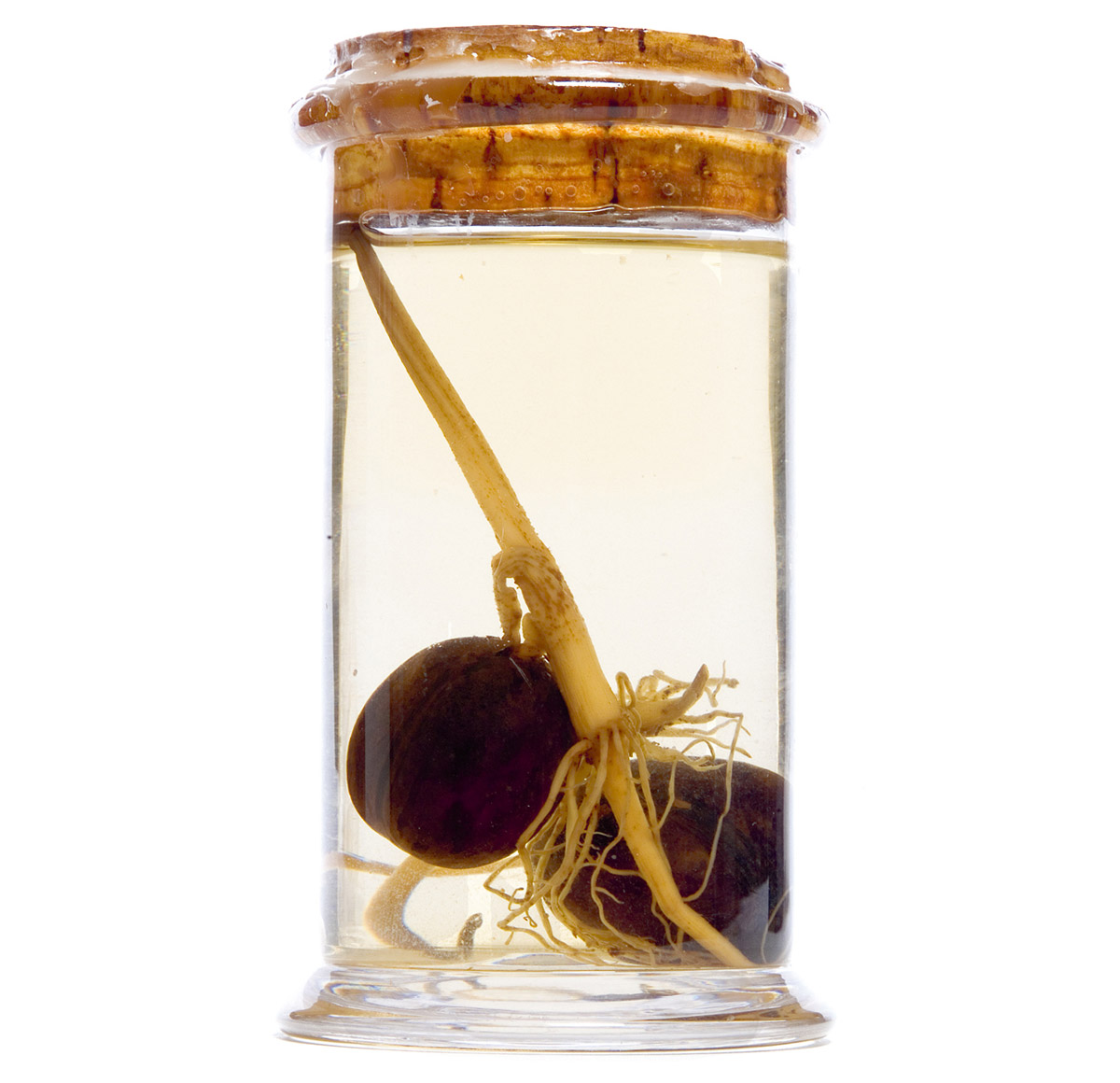
But more fundamentally, better bounce is a kind of bounce that is predictable, reliable, and manageable. This is what we actually mean when we say that a bounce is “true.” A true bounce is what allows a player to hit a good ball. Today’s rubber balls are industrial objects whose carefully calibrated specifications allow us to (at least ideally) count on their behavior and thus enable us to test out the material properties of our own bodies and our environments. The difference between a pristine official World Cup soccer ball, a slightly deflated version in a high school gym closet, and an approximation of these made with plastic bags, strips of cloth, and shredded tires is partially a difference based on how high these balls can bounce, but even more importantly, on how predictable their bounce is. The more predictable the bounce, the more it is able to be a fixed ground from which players can make virtuosic departures. A ball that behaves erratically, like the infamous Jabulani ball of the 2010 FIFA World Cup, garners vehement objections precisely because its unpredictable behavior prevents players from being able to demonstrate their narrowly channeled and highly practiced extraordinariness.
It seems worth pausing to wonder what kind of I’s and we’s are produced in a world whose sports desire, demand, and presume that the bounce of the ball (and the height of the net, and the temperature of the pool) be so utterly predictable—a world of sporting chance.[27] Because a bounce cannot actually be true or untrue. Bounce is simply a way to describe a kind of impact. It always only tells us how things are, and how well these things are lined up against our expectations and imaginations of how they should be.
- Beau Cronin, quoted in Jamin Warren, “Virtual Reality Will Save Games from Itself.” Available at killscreen.com/articles/virtual-reality-will-save-games-itself/.
- The “our” here is the “our” of an Anglophone world. Other languages and cultures draw the boundaries between play and not play differently.
- The technical term here is the “coefficient of restitution,” which is the ratio of speeds before and after an impact.
- Its other desirable property is, of course, its ability to resist water, a quality that we can leave aside for the purposes of this essay.
- Andrew Ciesielski, Introduction to Rubber Technology (Shawbury, UK: Smithers Rapra, 2001), p. 3.
- It is not known what the Olmec called themselves—there is only one extant example of their writing and it remains undeciphered. Western scholarship uses the name that the Nahuatl-speaking peoples of central Mexico, collectively referred to as the Aztec, gave to this much earlier civilization. “Aztec” is itself a problematic designation. Occidental historiography uses it both as an umbrella term for all Nahuatl-speaking societies—even though they themselves had, and continue to have, distinct names—and as the name for the most prominent of these societies encountered by the Europeans, who called themselves the Mexica and had their capital at Tenochtitlan (now Mexico City). These confusions are the result of the imposition of European concepts of “nation” and “empire” onto the societal structures of the pre-Columbian Americas.
- Variants of the ball game lay at the center of all three societies’ cosmologies. For a nuanced treatment of the Mesoamerican ball game, see E. Michael Whittington, ed., The Sport of Life and Death: The Mesoamerican Ballgame (New York: Thames & Hudson, 2001), the catalogue for the exhibition of the same name curated by Whittington.
- Peter Martyr d’Anghiera, cited in Michael J. Tarkanian and Dorothy Hosler, “An Ancient Tradition Continued: Modern Rubber Processing in Mexico,” in E. Michael Whittington, ed., The Sport of Life and Death, p. 118.
- Mary Miller, “The Maya Ballgame: Rebirth in the Court of Life and Death,” in E. Michael Whittington, ed. The Sport of Life and Death, p. 79.
- Diego Durán, cited in Laura Filloy Nadal, “Rubber and Rubber Balls in Mesoamerica,” in E. Michael Whittington, ed., The Sport of Life and Death, p. 23.
- This moment has been mostly absent from the history of ball sports, appearing as a footnote in some recent histories of rubber. Cortés’s purpose in bringing the Aztec performers along was part of his plan to amaze the court with the wealth and wonder of the New World as a means of fending off political accusations.
- This report comes from Gonzalo Fernández de Oviedo y Valdés, cited in Howard F. Cline, “Hernando Cortés and the Aztec Indians in Spain,” The Quarterly Journal of the Library of Congress, vol. 26, no. 2 (April 1969), p. 70. Valdés writes that these players played a game called “batey” with a large solid ball made from the “milk of certain trees.”
- Christoph Weiditz, cited in Howard F. Cline, “Hernando Cortés,” p. 75.
- John Fox, The Ball: Discovering the Object of the Game (New York: Harper Perennial, 2012), p. 123.
- Londa Schiebinger, Plants and Empire: Colonial Bioprospecting in the Atlantic World (Cambridge, MA: Harvard University Press, 2004), p. 3.
- Michael J. Tarkanian and Dorothy Hosler, “An Ancient Tradition Continued,” p. 117.
- See Walter D’Mignolo, The Darker Side of the Renaissance: Literacy, Territoriality, and Colonization (Ann Arbor: University of Michigan Press, 1995).
- Whereas the eighteenth-century Frenchmen François Fresneau de La Gataudière and Charles Marie de La Condamine developed their research on rubber after venturing to the sites of rubber collection, Charles Goodyear and Thomas Hancock knew only the material that arrived on their shores.
- Heiner Gillmeister, Tennis: A Cultural History (London: Leicester University Press, 1997), p. 186
- British Patent Index Class 132: Games, 1909–1915.
- Eustace Miles, Racquets, Tennis, and Squash (New York: D. Appleton and Company, 1903), p. 269.
- Heiner Gillmeister, Tennis, p. 177.
- Ibid.
- Lawn tennis soon came to dominate its parent sport to such an extent that it became known simply as tennis, while the older version was forced to take on various adjectives to distinguish it—real tennis, court tennis, and royal tennis, among others. Enthusiasts today still insist on calling this game tennis and refer to the modern sport as lawn tennis.
- The impending collapse of the market for wild rubber that the plantation saplings in Asia promised to set in motion created the pressures that contributed to two horrific massacres—in the Putumayo region of Peru and in the Congo—with practices of slavery, mutilation, and torture echoing across the ocean in terrifying ways.
- Dunlop’s own rubber empire started when in 1877 he used a valve from an “Airproof” football to create a pneumatic tire for his son’s bicycle in order to make the ride smoother and faster. Dunlop’s son won the cycling race he was entered in, and unlike the first and forgotten inventor of the pneumatic tire, Dunlop was able to capitalize on his invention because the nascent auto industry was in need of a better buffer from the road. The rise of car culture created a dramatically different scale of demand for rubber.
- Michel Serres conjures an image of teams of players passing a ball back and forth across a soccer field to explain his notion of the quasi-object. He writes: “The ball isn’t there for the body; the exact contrary is true: the body is the object of the ball; … the body follows the ball and orients it. … Participation is the passing of the “I” by passing. It is the abandon of my individuality or my being in a quasi-object that is there only to be circulated. It is rigorously the transubstantiation of being into relation.” See Michel Serres, The Parasite, trans. Lawrence R. Schehr (Baltimore & London: The John Hopkins University Press, 1982), pp. 226, 228.
Carlin Wing is a New York–based artist, and a doctoral candidate in the Department of Media, Culture, and Communication at New York University. Iterations of her ongoing project “Hitting Walls” have included a solo exhibition at Anthony Greaney, Boston (2009); a ball-making workshop at Machine Project, Los Angeles (2011); an article in the journal Games and Culture (2014); and a lecture performance at Villa Romana, Florence (2015). She is currently writing a dissertation titled “Bounce: The Material Certainty of Sporting Chance.”
Spotted an error? Email us at corrections at cabinetmagazine dot org.
If you’ve enjoyed the free articles that we offer on our site, please consider subscribing to our nonprofit magazine. You get twelve online issues and unlimited access to all our archives.